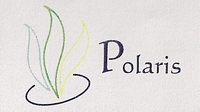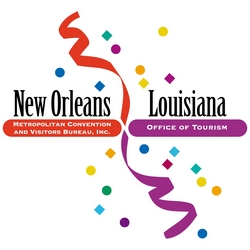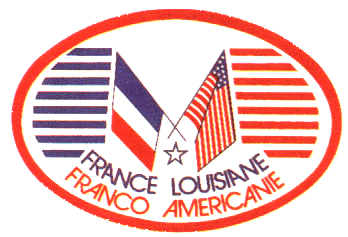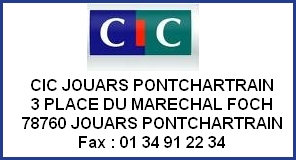Cadians, cajuns :
CADIANS ... CAJUNS ... “LES HARICOTS” THE BEANS ... ZYDECO ...
“WHAT’S THAT ?”
CAJUN : English alteration of the word Acadian, or Cadian
A strange odyssey, Acadian history is the story of a deportation.
In the 15th century, the "Old World" (France, Spain, Portugal, England) was fighting to conquer new territories. It is while searching for the "Passage to India" that Christopher Columbus, genoese navigator in the service of Spain, discovered America. Populated by nomadic tribes which probably came from Asia several thousand years ago, this distant continent remained unexplored. During the prehistory, the Mississippi basin was already a place for life, the first discoverers of the New World were Amerindians, Vikings, cod fishermen and trappers.
New France was annexed in 1541 by François I and Acadia (the maritime part of Canada) was founded in 1604.
Today, the Cajuns are the descendants of French settlers from Brittany, Poitou and Normandy. Skilled farmers and fishermen, they adapted themselves to this harsh climate, thanks to the
Mic-Mac Indians, and they lived more than one century in self-sufficiency, isolated from France.
In 1682, Robert Cavelier de la Salle explored the course of the Mississippi river, from the Great Lakes to its delta and baptised these new lands "Louisiana" in honour of King Louis XIV. In the early 18th century, French America was covering 1/3 of the American soil.
The incessant conflicts between France and England made Acadia become a British colony, further to the Treaty of Utrecht in 1713.
In 1755, wanting to eradicate this community which refused allegiance to the crown of England and the denial of its catholic faith, the Governor Charles Lawrence ordered the deportation of these rebels. Approximately 18,000 Acadians were driven out of their home; the families were separated throughout the British colonies or sent to jails. This was "Le Grand Dérangement" (The Great Upheaval).
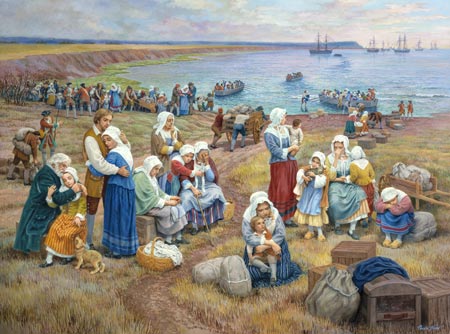
Ships Take Acadians Into Exile by Claude T. Picard
If some rejoined the Quebec, half of them perished in the oceans. After 9 years wandering on the seas or in prison of the east coast of America, in Europe, in the Caribbean or in Santo Domingo, the first survivors reached southern Louisiana, unaware that it was a Spanish territory since 1763.
There, rejected in the subtropical wetlands of the Mississippi - the Atchafalaya and the Bayous, with their “cocodrilles” (alligators), “maringoins” (mosquitoes), the “ouaouarons” (bullfrogs) in the “platains” (plains) - inside southern Louisiana ... they rebuilt their society, assimilating Indians, descendants of slaves and European immigrants, while safeguarding their traditions and their catholic religion. To survive, they fished and trapped in the “mèches” (swamps) or they cultivated lands in the meadows, they built wooden huts...
This multi-cultural mix gave birth to a new community: the Cadians, then Cajuns, who lived on the fringe of the English-speaking community: "Now, we are Americans, but not Englishmen!"
1803: For 15 million dollars, Napoleon sold Louisiana to the very young United States: people learned that they were French since 3 years, and then during the same year, they are now Americans! As they had a strong sense of humor, one of them said later "Rather than selling Louisiana, he would have done better to sell France !"
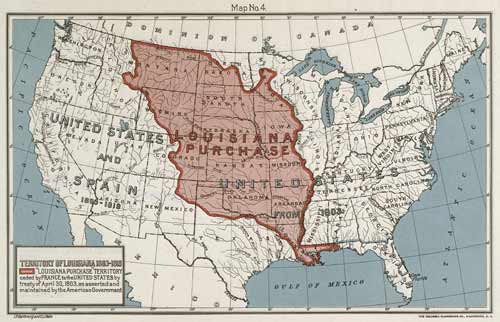
The Cajuns were always accompanied with music: old French songs sung at the evenings, religious songs, mouth reels to give rhythm to the dances, round and square dances, tales, ...
From 1760 onwards, with the violin appeared the "house-balls" or "Fais-Dodo", with mazurkas, polkas, minuets, dances, jigs, waltzes, one-step’s, two-steps.
In the late 19th century, the diatonic accordion, brought by the Germans, dominated with its powerful sound. A single tone, a single rank and ten keys meant that the musicians had to develop a very creative and living game. This will become the leading characteristic of this style.
The traditional tunes from the Poitou became more “exotic” in a gumbo of Creole rhythms, Indian recitative songs, enhanced by Mexican guitar and spiced by percussion: “'Tit fer” (triangle), washboard, and spoons ... a French Blues. They composed on the beat of horses or mules, expressing their joy of life, their sorrows of broken heart lovers or the rough life of everyday.
The 1st "hits" were recorded as far back as 1928.
The discovery of oil (around Jennings in 1901) and of natural gas, World War 1 and the industrialization made Louisiana emerge from its isolation. Under T. Roosevelt (1916), English language became mandatory: "One nation, one language".
At school, Cajuns were punished if they spoke French: "I will not speak French on the school grounds"... Their language was old rural French from the 17th century, studded with English words.
Many of them left Louisiana to go and work in the "oil" in Texas and in the Gulf of Mexico.
In the thirties, this Americanization led music to the country style and to the swing, to the electrification of the string-bands and ... to the English language. In 1948, Iry Lejeune, revived the traditional style and accordion, then with Nathan Abshire, it was the revival of the Cajun music. In 1960, Marc Savoy, a famous musician, starts the manufacturing of the "Acadian" accordions.
Initiated by intellectuals and musicians, the movement rushed in 1964, with the Newport Festival (the Balfa Brothers, among others) and the creation, in 1968, of the CODOFIL (Council for the Development of French in Louisiana) which upgraded the "French Heritage" (language - culture - music) - to which are attached near one million people of French ancestry.
ZYDECO: English alteration of the word: “(Les) Haricots” (Beans)
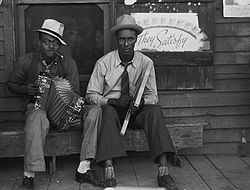
Zydeco players Louisiana 1938
This is another deportation undergone by the Africans enslaved in the cotton, sugar cane and indigo plantations from 1713 until the Civil War, and the Haitians who arrived after the revolution in Santo Domingo. Freed, those who settled in Acadiana will blend with the Cajuns, becoming Catholic and farmers on their turn. As the white people, they mastered violin, accordion and French music, and like them, they played in the house-balls. Only a few months after the first recording by the white Cajun Joseph Falcon : "Allons à Lafayette" (1928), two black Creoles, the fiddler Douglas Bellard (La Valse de la Prison) and the accordionist Amedee Ardoin (6 titles with the white Cajun Dennis McGee), also recorded in 1929. Amedee Ardoin is now considered as the pioneer of “Haricots” (Beans) music.
Sometimes called "la la", the music of the Creoles became Zarico - in English language: Zydeco - defined by "beans are not salty," inspired by a song from the Creole south-western Louisiana. Popularized by Clifton Chenier (from Opelousas) in the early sixties, the piano accordion appeared. This accordion is often chromatic and more repetitive. The washboard and the electric guitar is very present, you can even hear a solo of trumpet or saxophone in a tune. If Clifton Chenier's Zydeco (as the one played in the Creole neighbourhoods of Texan cities like Houston, Galveston or Port Arthur) is more Rhythm & Blues and Rock n' Roll, the Zydeco played at the same time by Boozoo Chavis, also coming from a rural area (Lake Charles), is a wilder sound, more dissonant and syncopated near to trance, from Afro-Caribbean-American roots, it will build up the modern Zydeco.
Zydeco is hot!
Today, new generations continue the movement with talent and vitality. The music evolves, always with spicy Cajun words, percussions and bass are more present, a more intimate mixture with the Creole Zydeco sung in English, and with the resurgence of the gypsy shaded Western Swing.
The Cajuns are known for their sense of hospitality, friendliness and celebration.
In Louisiana, the festivals are happening one after the other throughout the year. Mardi-Gras is almost a national holiday! You can eat the Creole cuisine in a warm atmosphere, you can dance to the sound of a swinging, contagious and spicy music, with the rhythms of the Two-Step, Waltz, Cajun Freeze or Zydeco, and ... you let the good times roll
VIVIANE MARTINET
(Translated by M&M's)










